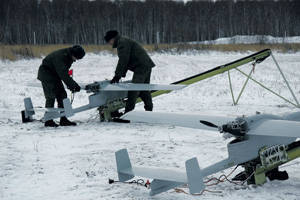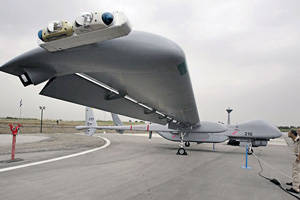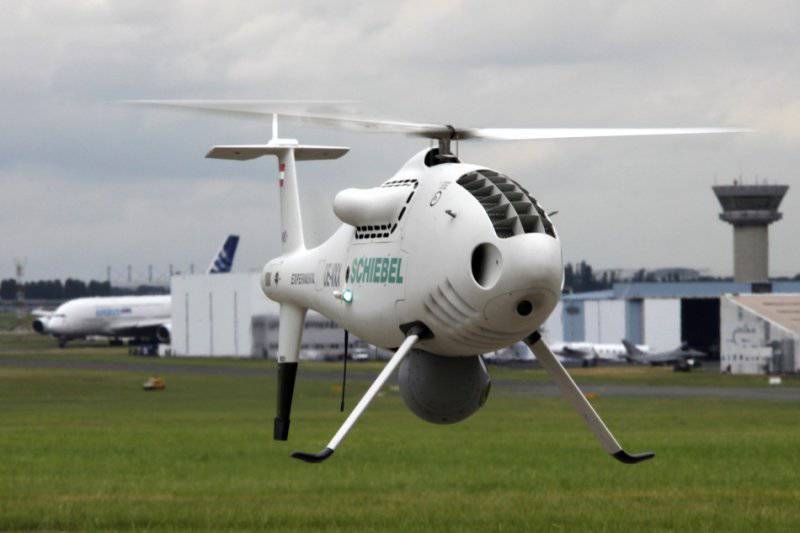UAVs in green caps. Worldwide experience in the use of UAVs in the protection of state borders
In recent years, in addition to the purely military field of application of unmanned systems, paramilitary fields have been developing more and more actively. One such area is aerial monitoring of borders and coasts. Application efficiency drones for these tasks has already been evaluated in a fairly large number of countries of the world, which stimulates more and more countries to join this high-tech race.
USA
The United States was a pioneer in the use of UAVs in order to protect the state border. Back in 2004, they tested the Hermes-450 drones to patrol the border with Mexico.
Currently, the US Customs and Border Guard is armed with about 300 aircraft, including six Predator B (Reaper) unmanned aerial vehicles manufactured by General Atomics Aeronautical Systems, Calif.
Three drone Predator B, owned by the US Customs and Border Protection, are located at a base south of Tucson, Arizona. UAVs patrol the US-Mexico border. In addition, it is planned to attract another Predator B to the operations on the fight against drugs, modified for the task of patrolling the coastal strip in the southeastern United States.
U.S. Department of Defense drones are also involved in drug control operations. "Unmanned aviation systems play an important role in supporting the efforts of allies around the world to prevent the illicit drug trade, ”said US Department of Defense spokesman Bob Mehl. However, he avoided discussing the details. Nevertheless, it is known that the United States Joint Command in the Central and South America (Southern Command - SOUTHCOM), responsible for military operations in the Latin American zone, has provided a testing ground for unmanned systems.
ISRAEL
Israel, one of the trendsetters in the field of UAV systems, is also actively using drones for air patrols of its borders and coast. Information on the use of unmanned systems in the country is limited. According to available data, IDF drones are used for airborne patrols.
Last year, data appeared in the media referring to representatives of the Israeli Ministry of Defense that the country's air force had deployed unmanned aircraft systems to monitor the 250-kilometer section of the border with Egypt, which was caused by the penetration of armed groups into Israel from the territory of the neighboring country. In addition, it is obvious that other parts of the border are constantly monitored. Special attention is also represented by the border with Lebanon and the long Mediterranean coast.
According to reports, the performance of these tasks involved mainly relatively heavy drones Hermes 450, Heron and Eitan.
INDIA
In 2012, India announced plans to increase fleet UAV systems used. For these purposes, it was planned to spend more than $ 2 billion. One of the main functions for which unmanned systems in India are used is border protection. The power structures of India noted the effectiveness of UAV systems to detect border violators.
UAVs are planned to be used mainly in smuggling operations in the northern state of Jammu and Kashmir on the border with Pakistan. One of the requirements for UAVs designed for this purpose is the automatic tracking of detected ground targets. In addition, India intends to use drones to patrol the border with China.
The required number of mini-class UAVs for power structures in India is estimated at more than 700 units. At the same time, taking into account already existing UAVs, only in the Indian Army their total number by 2017 should increase to 1,6 thousand units. This increase is reportedly required to improve situational awareness of border areas.
As for the specific systems used to guard the border in India, it is worth recalling that the country has long cooperated with Israel in the field of UAV systems. In particular, India has acquired a significant number of various modifications of the Serarcher UAV, as well as the Heron UAV from the Israeli company IAI. In addition, the country is also developing its own unmanned systems, including a fairly large class, such as Nishant and Rustom.
CHINA
 Interspecific Training Center - flying day for UAVs.
Interspecific Training Center - flying day for UAVs.The PRC is actively working on the development of UAV programs to perform the tasks of monitoring the border and coast of the country. Recently it became known about China’s plans to send UAVs to the border with Myanmar to participate in operations to curb drug trafficking. Authorities in Liaoning Province have announced the use of unmanned systems to monitor the border with North Korea. The People's Republic of China also plans to create two UAV bases on the coast. With them, in particular, are going to monitor activity in the South China Sea.
The program to create UAV systems in the PRC to some extent was based on Israeli technologies - in the 1990-e China, Israeli Harpy unmanned systems were purchased. Currently, the Chinese corporation CATIC has developed a series of UAVs, at least two of which are now in use. The first of these, the ASN-15, is a mini-UAV that is close in dimension to the American Raven UAV. The second, ASN-209, is larger and is a tactical device, approaching in dimension to the Searcher UAV. In addition, the Chengdu Research Aviation Institute (CADI) created the Pterodactyl UAV, and the Chinese Aerospace and Technology Corporation (CASC) created the CH-4 UAV.
Attention is paid to the PRC and helicopter-type unmanned vehicles. Some experience here was obtained after the acquisition of the Camcopter S-100 UAV from the Austrian company Schiebel. Currently, China is working on a heavier machine - V750. According to some reports, it is already used by Chinese operators.
EUROPE
In the European Union, in 2006, it was decided to use unmanned aerial vehicles to patrol borders in the English Channel and the Mediterranean coast. It was reported that the UAVs will be used to patrol the border in the Balkan Peninsula. The use of unmanned aerial vehicles is part of the plan of the EU government to equip customs and border services with modern tracking systems, and 1,6 billion are allocated for this program.
Experiments using UAVs in border patrols have already been carried out in selected European countries. So, France, as reported, used for this purpose the UAV Patroller, created by Sagem on the basis of the manned motor glider Stemme. In Italy, UAVs Reaper, purchased in 2008 – 2009 in the USA, were also supposed to be used to protect the border.
A recent report on security, prepared by the office of EU Foreign Minister Catherine Ashton, recommends that European countries use unmanned aerial military systems to solve airborne border patrols. The plan emphasizes the security priorities of the December EU summit. In particular, the document notes a high need for the development of a MALE-class UAV. It is expected that this decision will increase the competition of companies engaged in the development and production of relevant systems in the European market.
LATIN AMERICA
According to various sources, the Mexican government purchased the Elmes Hermes 450 unmanned system from Elbit Systems, which is close in dimension to the Heron UAV, which operates flights from Ensenada, south of Tijuana.
Residents of Ensenada have already become accustomed to flying UAVs over the city, and one of them was even photographed by a journalist from the local news agency Agencia Fronteriza de Noticias de Tijuana and later identified by characteristic outlines as Hermes 450 of the Israeli company Elbit Systems. It seems that in September 2008, several Hermes UAVs were purchased by Mexico when Elbit Systems announced in a press release that it had concluded a deal worth 25 million dollars for the sale of Hermes UAVs and Skylark smaller drones with an unnamed state.
In March, 2009, Eduardo Lariss MacGregor, who is in charge of conducting air operations in the interests of the Mexican federal police, told Mexican journalists that the country's drone fleet consists of four mini-UAVs and four aerostat-type airborne vehicles. All eight UAVs are used in the hottest spots in the fight against drug traffickers, including the cities of Ciudad Juarez, Culiacan and Tijuana. Here, apparently, they meant the Orbiter mini-UAV, created by Aeronautics Defense Systems Ltd. They are intended for use in reconnaissance and observation in the near zone and can be used in urban conditions and small-scale conflicts. The balloon systems used in the country appear to be Skystar 300 systems of the same company.
The Mexican Department of Public Security, responsible for coordinating anti-drug trafficking in the country, presented its own program to develop unmanned mini-vehicles to monitor the actions of drug cartels. The Mexican company Hydra Technologies, which developed and produces the E1 Gavilan mini-UAV, the S4 Ehecatl tactical UAV and the larger S5 Cuculcan UAV, is leading in the national drone production program.
The Brazilian federal police, which is responsible for controlling the nearly 17000-kilometer border in remote areas of the country bordering the 10 states, has developed the world's largest non-military UAV use program. The starting point for equipping Brazilian security forces with modern UAV systems is the Heron UAV demonstration flights, which were conducted at the end of July 2009, in São Miguel do Iguaçu, near the Brazilian border with Paraguay and Argentina.
Currently flying two UAVs Hermes 450, assigned to the air base Santa Maria Air Force in the state of Rio Grande do Sul. In addition, one unit Heron 1 belongs to the Brazilian police. He oversees the terrain in the state of Paraná.
 Israeli drone Eitan.
Israeli drone Eitan.By 2014, Brazilian police are planning to equip four sites with Heron 1 drones. “Heron drones will fly from four air bases in different parts of Brazil,” said a Justice Ministry spokesman, talking about the possibility of Heron’s UAVs taking photographs and video of ground targets from 9000 meters. According to the Agencia Brasil state news agency, some of the flights are over the sparsely populated area in the Amazon.
Unmanned border monitoring systems are also developing in other Latin American countries. The three leaders here, perhaps, closes Ecuador. In 2008, President Rafael Correa terminated an agreement with the United States allowing the Pentagon to conduct reconnaissance and patrol flights from the forward operational base in the city of Manta. To fill the gap in the patrol flights, the state purchased four Searcher UAVs and two Heron UAVs.
New drones are deployed at the Manta base, from where they make patrol flights along the coast in search of drug traffickers and coyotes, as people involved in human trafficking are called here. In addition, UAVs also strengthen the northern border of Ecuador with Colombia.
RUSSIA
The large length of the land border and coast, the vast area of exclusive economic zone of Russia - all this necessitates the use of new highly effective means of monitoring. One of the functional elements here are gradually becoming a UAV system. Russian border units already have some experience with the use of unmanned systems in the protection of the state border in various parts of it.
By the beginning of 2010, the FSB had experience of using for the aerial reconnaissance of the domestic UAX Eleron, developed by Enix. In addition, in the 2010 year, Vladimir Pronichev, then the head of the Border Guard Service of the Federal Security Service of Russia, announced the purchase of seven complexes with small-sized UAVs produced by Russian companies. According to him, the new items were sent for operational tests. Recently, the coast guard of the FSB of Russia FS acquired two Camcopter S-100 UAVs developed by the Austrian company Schiebel, which were licensed assembled in Rostov-on-Don.
At present, in the Frontier Service of the Federal Security Service of Russia, aviation specialists at the training center in the city of Yoshkar-Ola are actively preparing the calculations of unmanned aircraft complexes, accumulating experience in operating both the aircraft themselves and their target load, various tactics and methods of action are being worked out. In the near future, after a single purchase may follow larger batches of unmanned systems. It seems that in the future, even heavier UAVs can be used, adapted for operation in harsh climatic conditions, including from coastal and island airfields in the Arctic.
UAVs as a new technical tool offer ample opportunities and can significantly improve the efficiency of solving a number of tasks, including controlling difficult-to-reach sections of the border, coast, torrential zones, estuaries of large rivers, as well as countering major criminal smuggling and terrorist groups.
On the other hand, it is worth noting the fact that the use of UAVs in paramilitary areas, including border patrols, is hampered by the presence of a number of bottlenecks. First, it is the habit of border guards and flight personnel to operate manned vehicles. Secondly, some inertia in decision-making on the part of responsible structures. Thirdly, this is the absence or extremely slow formation of the infrastructure necessary for the operation of unmanned systems. And finally, in the fourth, this is the unresolved issues of the use of UAV systems in the general airspace with other unmanned and manned aircraft.
Nevertheless, these issues can be solved in principle. A rather saturated market of unmanned systems, generated by the tasks of airborne border monitoring, stimulates enterprises to search for possible solutions.

Information